
Digital television (DTV) is the transmission of television signals using digital encoding, in contrast to the earlier analog television technology which used analog signals. At the time of its development it was considered an innovative advancement and represented the first significant evolution in television technology since color television in the 1950s. Modern digital television is transmitted in high-definition television (HDTV) with greater resolution than analog TV. It typically uses a widescreen aspect ratio in contrast to the narrower format of analog TV. It makes more economical use of scarce radio spectrum space; it can transmit up to seven channels in the same bandwidth as a single analog channel, and provides many new features that analog television cannot. A transition from analog to digital broadcasting began around 2000. Different digital television broadcasting standards have been adopted in different parts of the world; below are the more widely used standards:
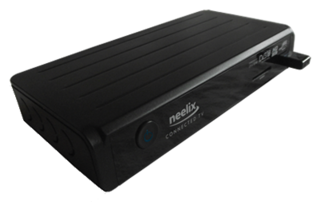
A set-top box (STB), also colloquially known as a cable box or receiver and historically television decoder, is an information appliance device that generally contains a TV-tuner input and displays output to a television set and an external source of signal, turning the source signal into content in a form that can then be displayed on the television screen or other display device. They are used in cable television, satellite television, and over-the-air television systems as well as other uses.
A digital video recorder (DVR) is an electronic device that records video in a digital format to a disk drive, USB flash drive, SD memory card, SSD or other local or networked mass storage device. The term includes set-top boxes with direct to disk recording, portable media players and TV gateways with recording capability, and digital camcorders. Personal computers are often connected to video capture devices and used as DVRs; in such cases the application software used to record video is an integral part of the DVR. Many DVRs are classified as consumer electronic devices; such devices may alternatively be referred to as personal video recorders (PVRs), particularly in Canada. Similar small devices with built-in displays and SSD support may be used for professional film or video production, as these recorders often do not have the limitations that built-in recorders in cameras have, offering wider codec support, the removal of recording time limitations and higher bitrates.

CableCARD is a special-use PC Card device that allows consumers in the United States to view and record digital cable television channels on digital video recorders, personal computers and television sets on equipment such as a set-top box not provided by a cable television company. The card is usually provided by the local cable operator, typically for a nominal monthly fee.
Globally Executable MHP (GEM) is a DVB specification of a Java based middleware for TV broadcast receivers, IPTV terminals and Blu-ray players. GEM is an ETSI standard and an ITU "Recommendation”. GEM defines a set of common functionalities which are independent from the signaling and protocols of a specific transmission network and enables to write interoperable Java applications for TV. GEM is not intended to be directly implemented, but rather forms the basis for broader specifications targeting a particular network infrastructure or class of device. GEM defines profiles for different device classes (targets) – these define the set of available features of GEM for this device class. Currently GEM defines targets for broadcast, packaged media (Blu-Ray) and IPTV. Combinations of these targets can be combined into a hybrid GEM platform, which enables to build devices with multiple network interfaces, such as a combined broadcast/IPTV set-top box.
The Technology and Engineering Emmy Awards, or Technology and Engineering Emmys, are one of two sets of Emmy Awards that are presented for outstanding achievement in engineering development in the television industry. The Technology and Engineering Emmy Awards are presented by the National Academy of Television Arts and Sciences (NATAS), while the separate Primetime Engineering Emmy Awards are given by its sister organization the Academy of Television Arts & Sciences (ATAS).
The OpenCable Application Platform, or OCAP, is an operating system layer designed for consumer electronics that connect to a cable television system, the Java-based middleware portion of the platform. Unlike operating systems on a personal computer, the cable company controls what OCAP programs run on the consumer's machine. Designed by CableLabs for the cable networks of North America, OCAP programs are intended for interactive services such as eCommerce, online banking, Electronic program guides, and digital video recording. Cable companies have required OCAP as part of the Cablecard 2.0 specification, a proposal that is controversial and has not been approved by the Federal Communications Commission. Cable companies have stated that two-way communications by third party devices on their networks will require them to support OCAP. The Consumer Electronics Association and other groups argue OCAP is intended to block features that compete with cable company provided services and that consumers should be entitled to add, delete and otherwise control programs as on their personal computers. On January 8, 2008 CableLabs announced the Tru2Way brand for the OpenCable platform, including OCAP as the application platform.
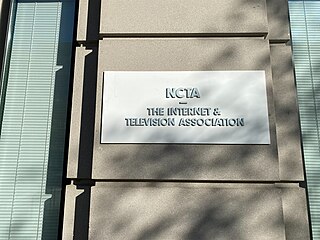
NCTA – The Internet & Television Association is the principal trade association for the U.S. broadband and pay television industries. It represents more than 90% of the U.S. cable market, more than 200 cable networks, and equipment suppliers and providers of other services to the cable industry.
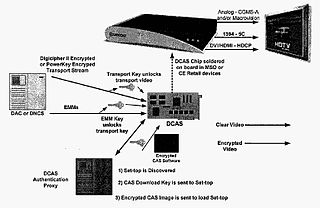
Downloadable Conditional Access System or DCAS was a proposal advanced by CableLabs for secure software download of a specific Conditional Access client which controls digital rights management (DRM) into an OCAP-compliant host consumer media device. The National Cable & Telecommunications Association (NCTA) proposed that DCAS be used as a substitute for physical CableCARDs, a standard also created by CableLabs for which products began appearing in August 2004 as part of industry compliance to the FCC mandate, which in turn is pursuant to the Telecommunications Act of 1996. DCAS is growing in popularity as a less expensive alternative for CableCARD, with major North American operator deployments from Cablevision and Charter. DCAS deployments can be expected to grow in the coming years, thanks to favorable regulatory view from the STELA Reauthorization Act of 2014 and FCC appointing a Downloadable Security Technical Advisory Committee, and wider support for key ladder (K-LAD) functionality from system-on-chip (SoC) vendors and set-top box manufacturers.
Cable-ready is a designation which indicates that a TV set or other television-receiving device is capable of receiving cable TV without a set-top box.

Switched video or switched digital video (SDV), sometimes referred to as switched broadcast (SWB), is a telecommunications industry term for a network scheme for distributing digital video via a cable. Switched video sends the digital video more efficiently freeing bandwidth. The scheme applies to digital video distribution both on typical cable TV systems using QAM channels, or on IPTV systems.
Multichannel television in the United States has been available since at least 1948. The United States is served by multichannel television through cable television systems, direct-broadcast satellite providers, and various other wireline video providers; among the largest television providers in the U.S. are DirecTV, Altice USA, Charter Communications, Comcast, Dish Network, and Verizon Communications. The Telecommunications Act of 1996 defines a multichannel video programming distributor (MVPD) as "a person such as, but not limited to, a cable operator, a multichannel multipoint distribution service, a direct broadcast satellite service, or a television receive-only satellite program distributor, who makes available for purchase, by subscribers or customers, multiple channels of video programming", where a channel is defined as a "signaling path provided by a cable television system."
Interactive television standards are standards for television broadcasting that relate to different modes of interaction and feedback mechanisms. This interaction system is what creates an extension to the general, traditional television experience.

A cable converter box or television converter box is an electronic tuning device that transposes/converts channels from a cable television service to an analog RF signal on a single channel, usually VHF channel 3 or 4, or to a different output for digital televisions such as HDMI.

OEDN is an OpenCable Application Platform (OCAP) EBIF Developer Network that was founded in October, 2007. It is an online developer network for the promotion of Interactive Television application and service development on digital cable television.
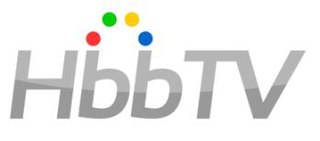
Hybrid Broadcast Broadband TV (HbbTV) is both an industry standard and promotional initiative for hybrid digital TV to harmonise the broadcast, Internet Protocol Television (IPTV), and broadband delivery of entertainment to the end consumer through connected TVs and set-top boxes. The HbbTV Association, comprising digital broadcasting and Internet industry companies, has established a standard for the delivery of broadcast TV and broadband TV to the home, through a single user interface, creating an open platform as an alternative to proprietary technologies. Products and services using the HbbTV standard can operate over different broadcasting technologies, such as satellite, cable, or terrestrial networks.
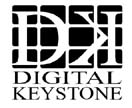
Digital Keystone, Inc. is a video technology company, based in Cupertino, California, that develops digital entertainment technologies that bridge Pay TV with the new digital home. DK solutions include security and navigation software. Digital Keystone also develops industry-standard validation tools for development, certification, and manufacturing. DK technologies enable content access throughout the entire home, offering security, interactive services, and device connectivity.
AllVid was a proposal to develop technology enabling smart broadband-connected video devices to access the content on the managed networks of cable operators, telcos, and satellite-TV operators. It was initially proposed in the U.S. Federal Communications Commission's (FCC) National Broadband Plan in 2010. The AllVid hardware would act as a universal adapter for all types of pay TV content such as video-on-demand and pay-per-view, as well as interactive programming guides, delivered through a wide variety of means, including cable TV, satellite TV, VDSL, IPTV, and Internet TV.
A smart TV, also known as a connected TV (CTV), is a traditional television set with integrated Internet and interactive Web 2.0 features, which allows users to stream music and videos, browse the internet, and view photos. Smart TVs are a technological convergence of computers, televisions, and digital media players. Besides the traditional functions of television sets provided through traditional broadcasting media, these devices can provide access to over-the-top media services such as streaming television and internet radio, along with home networking access.
The 59th Technology and Engineering Emmy Awards was held on January 8, 2008 at the 2008 International Consumer Electronics Show in Las Vegas.









